IB-7013 - Cultural Impact on Global Marketing Environment
VerifiedAdded on 2023/06/04
|9
|2413
|217
Essay
AI Summary
This essay explores the significant impact of cultural backgrounds on international marketing, reviewing three marketing blunders from the past 25 years and suggesting preventative measures. It analyzes cultural misunderstandings that led to these mistakes, emphasizing the importance of collaborating with local advertising agencies for global ventures. The discussion highlights the critical nature of cultural risk, equating its importance to political and commercial risks in international marketing. The essay concludes with a hypothetical business visit to a South Asian country, examining how cultural differences can impede effective business marketing, and stresses the need for cultural sensitivity and adaptation in global marketing strategies, recommending consultation with local agencies to ensure culturally appropriate and successful campaigns. Desklib is your go-to platform for accessing similar solved assignments.
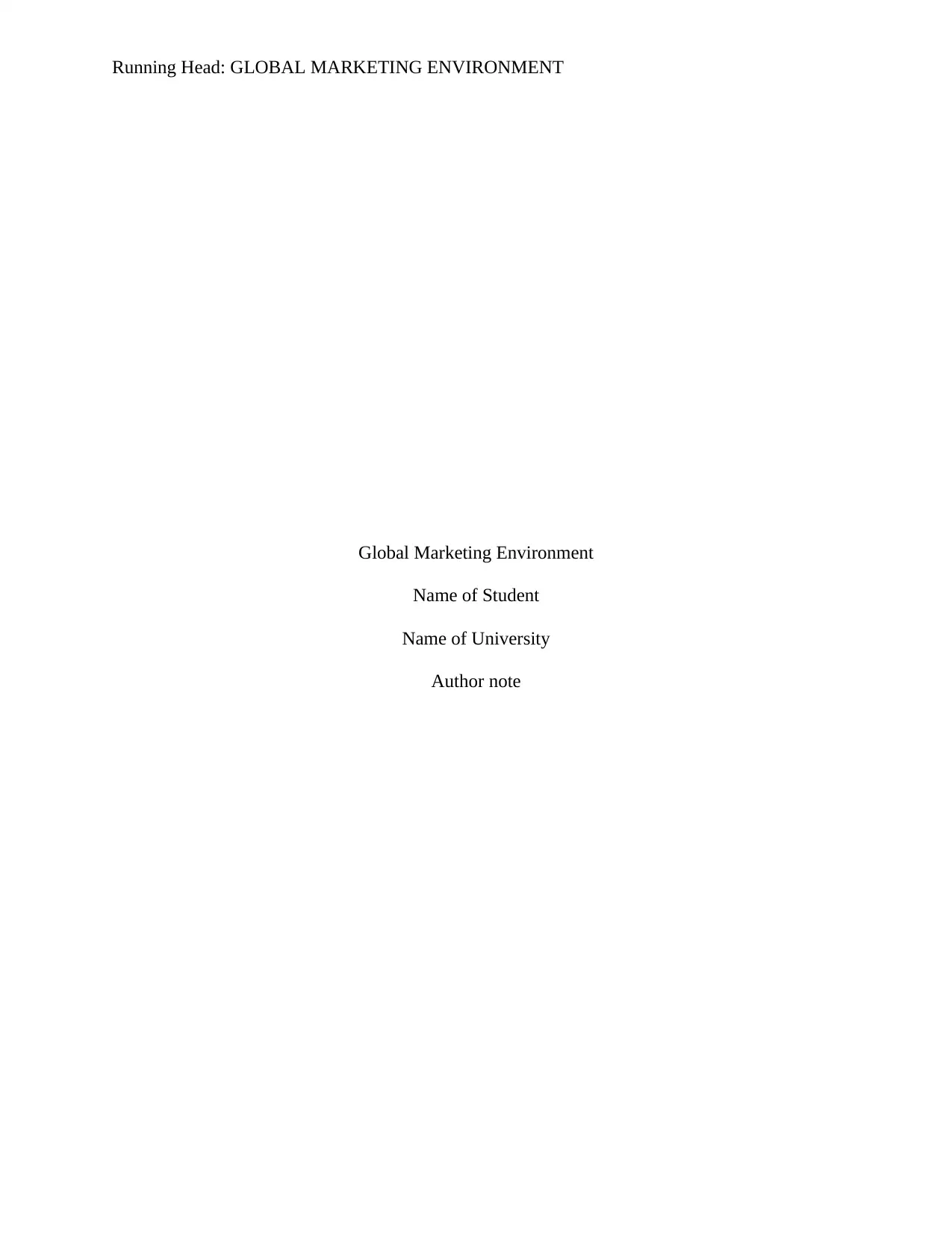
Running Head: GLOBAL MARKETING ENVIRONMENT
Global Marketing Environment
Name of Student
Name of University
Author note
Global Marketing Environment
Name of Student
Name of University
Author note
Paraphrase This Document
Need a fresh take? Get an instant paraphrase of this document with our AI Paraphraser
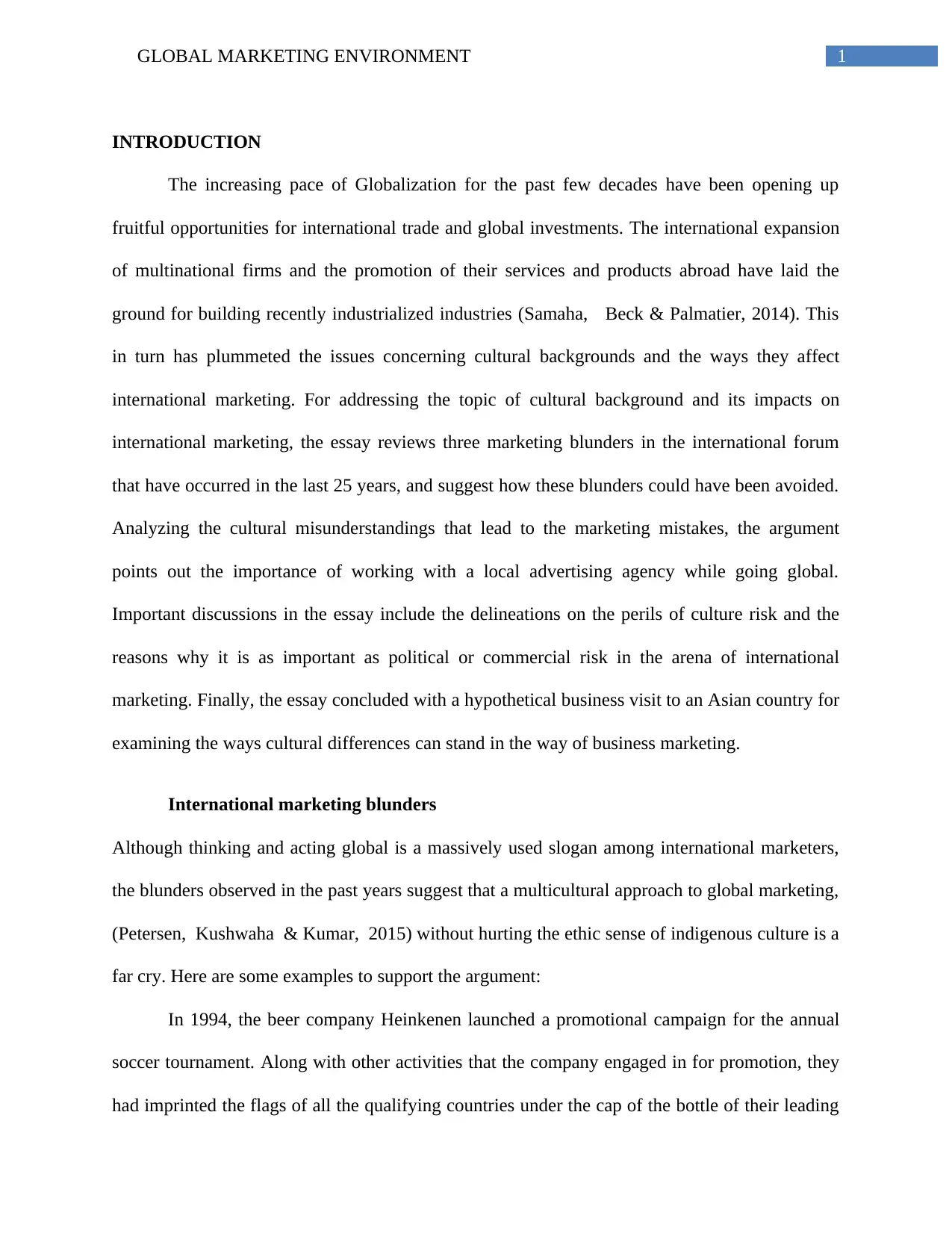
1GLOBAL MARKETING ENVIRONMENT
INTRODUCTION
The increasing pace of Globalization for the past few decades have been opening up
fruitful opportunities for international trade and global investments. The international expansion
of multinational firms and the promotion of their services and products abroad have laid the
ground for building recently industrialized industries (Samaha, Beck & Palmatier, 2014). This
in turn has plummeted the issues concerning cultural backgrounds and the ways they affect
international marketing. For addressing the topic of cultural background and its impacts on
international marketing, the essay reviews three marketing blunders in the international forum
that have occurred in the last 25 years, and suggest how these blunders could have been avoided.
Analyzing the cultural misunderstandings that lead to the marketing mistakes, the argument
points out the importance of working with a local advertising agency while going global.
Important discussions in the essay include the delineations on the perils of culture risk and the
reasons why it is as important as political or commercial risk in the arena of international
marketing. Finally, the essay concluded with a hypothetical business visit to an Asian country for
examining the ways cultural differences can stand in the way of business marketing.
International marketing blunders
Although thinking and acting global is a massively used slogan among international marketers,
the blunders observed in the past years suggest that a multicultural approach to global marketing,
(Petersen, Kushwaha & Kumar, 2015) without hurting the ethic sense of indigenous culture is a
far cry. Here are some examples to support the argument:
In 1994, the beer company Heinkenen launched a promotional campaign for the annual
soccer tournament. Along with other activities that the company engaged in for promotion, they
had imprinted the flags of all the qualifying countries under the cap of the bottle of their leading
INTRODUCTION
The increasing pace of Globalization for the past few decades have been opening up
fruitful opportunities for international trade and global investments. The international expansion
of multinational firms and the promotion of their services and products abroad have laid the
ground for building recently industrialized industries (Samaha, Beck & Palmatier, 2014). This
in turn has plummeted the issues concerning cultural backgrounds and the ways they affect
international marketing. For addressing the topic of cultural background and its impacts on
international marketing, the essay reviews three marketing blunders in the international forum
that have occurred in the last 25 years, and suggest how these blunders could have been avoided.
Analyzing the cultural misunderstandings that lead to the marketing mistakes, the argument
points out the importance of working with a local advertising agency while going global.
Important discussions in the essay include the delineations on the perils of culture risk and the
reasons why it is as important as political or commercial risk in the arena of international
marketing. Finally, the essay concluded with a hypothetical business visit to an Asian country for
examining the ways cultural differences can stand in the way of business marketing.
International marketing blunders
Although thinking and acting global is a massively used slogan among international marketers,
the blunders observed in the past years suggest that a multicultural approach to global marketing,
(Petersen, Kushwaha & Kumar, 2015) without hurting the ethic sense of indigenous culture is a
far cry. Here are some examples to support the argument:
In 1994, the beer company Heinkenen launched a promotional campaign for the annual
soccer tournament. Along with other activities that the company engaged in for promotion, they
had imprinted the flags of all the qualifying countries under the cap of the bottle of their leading
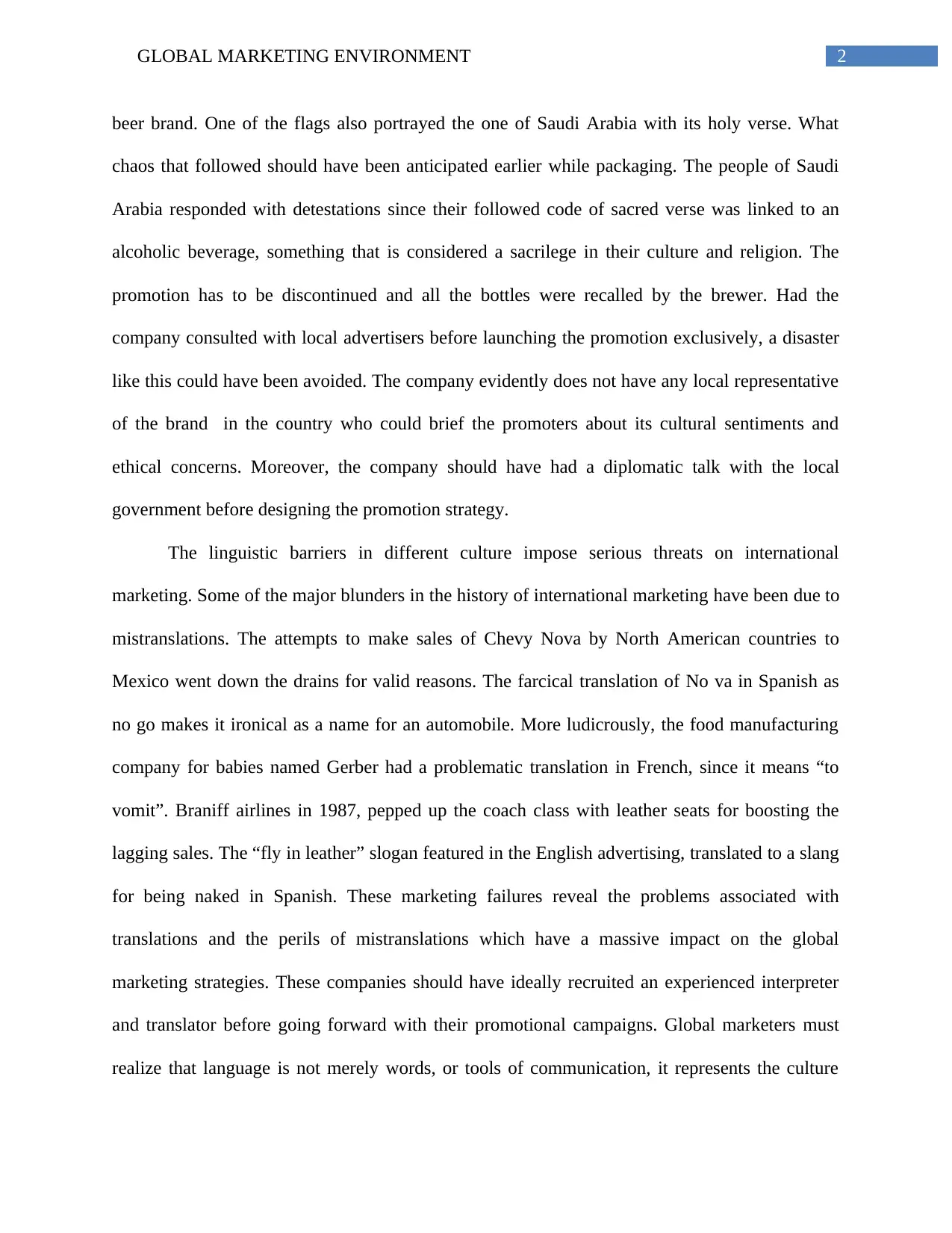
2GLOBAL MARKETING ENVIRONMENT
beer brand. One of the flags also portrayed the one of Saudi Arabia with its holy verse. What
chaos that followed should have been anticipated earlier while packaging. The people of Saudi
Arabia responded with detestations since their followed code of sacred verse was linked to an
alcoholic beverage, something that is considered a sacrilege in their culture and religion. The
promotion has to be discontinued and all the bottles were recalled by the brewer. Had the
company consulted with local advertisers before launching the promotion exclusively, a disaster
like this could have been avoided. The company evidently does not have any local representative
of the brand in the country who could brief the promoters about its cultural sentiments and
ethical concerns. Moreover, the company should have had a diplomatic talk with the local
government before designing the promotion strategy.
The linguistic barriers in different culture impose serious threats on international
marketing. Some of the major blunders in the history of international marketing have been due to
mistranslations. The attempts to make sales of Chevy Nova by North American countries to
Mexico went down the drains for valid reasons. The farcical translation of No va in Spanish as
no go makes it ironical as a name for an automobile. More ludicrously, the food manufacturing
company for babies named Gerber had a problematic translation in French, since it means “to
vomit”. Braniff airlines in 1987, pepped up the coach class with leather seats for boosting the
lagging sales. The “fly in leather” slogan featured in the English advertising, translated to a slang
for being naked in Spanish. These marketing failures reveal the problems associated with
translations and the perils of mistranslations which have a massive impact on the global
marketing strategies. These companies should have ideally recruited an experienced interpreter
and translator before going forward with their promotional campaigns. Global marketers must
realize that language is not merely words, or tools of communication, it represents the culture
beer brand. One of the flags also portrayed the one of Saudi Arabia with its holy verse. What
chaos that followed should have been anticipated earlier while packaging. The people of Saudi
Arabia responded with detestations since their followed code of sacred verse was linked to an
alcoholic beverage, something that is considered a sacrilege in their culture and religion. The
promotion has to be discontinued and all the bottles were recalled by the brewer. Had the
company consulted with local advertisers before launching the promotion exclusively, a disaster
like this could have been avoided. The company evidently does not have any local representative
of the brand in the country who could brief the promoters about its cultural sentiments and
ethical concerns. Moreover, the company should have had a diplomatic talk with the local
government before designing the promotion strategy.
The linguistic barriers in different culture impose serious threats on international
marketing. Some of the major blunders in the history of international marketing have been due to
mistranslations. The attempts to make sales of Chevy Nova by North American countries to
Mexico went down the drains for valid reasons. The farcical translation of No va in Spanish as
no go makes it ironical as a name for an automobile. More ludicrously, the food manufacturing
company for babies named Gerber had a problematic translation in French, since it means “to
vomit”. Braniff airlines in 1987, pepped up the coach class with leather seats for boosting the
lagging sales. The “fly in leather” slogan featured in the English advertising, translated to a slang
for being naked in Spanish. These marketing failures reveal the problems associated with
translations and the perils of mistranslations which have a massive impact on the global
marketing strategies. These companies should have ideally recruited an experienced interpreter
and translator before going forward with their promotional campaigns. Global marketers must
realize that language is not merely words, or tools of communication, it represents the culture
⊘ This is a preview!⊘
Do you want full access?
Subscribe today to unlock all pages.

Trusted by 1+ million students worldwide
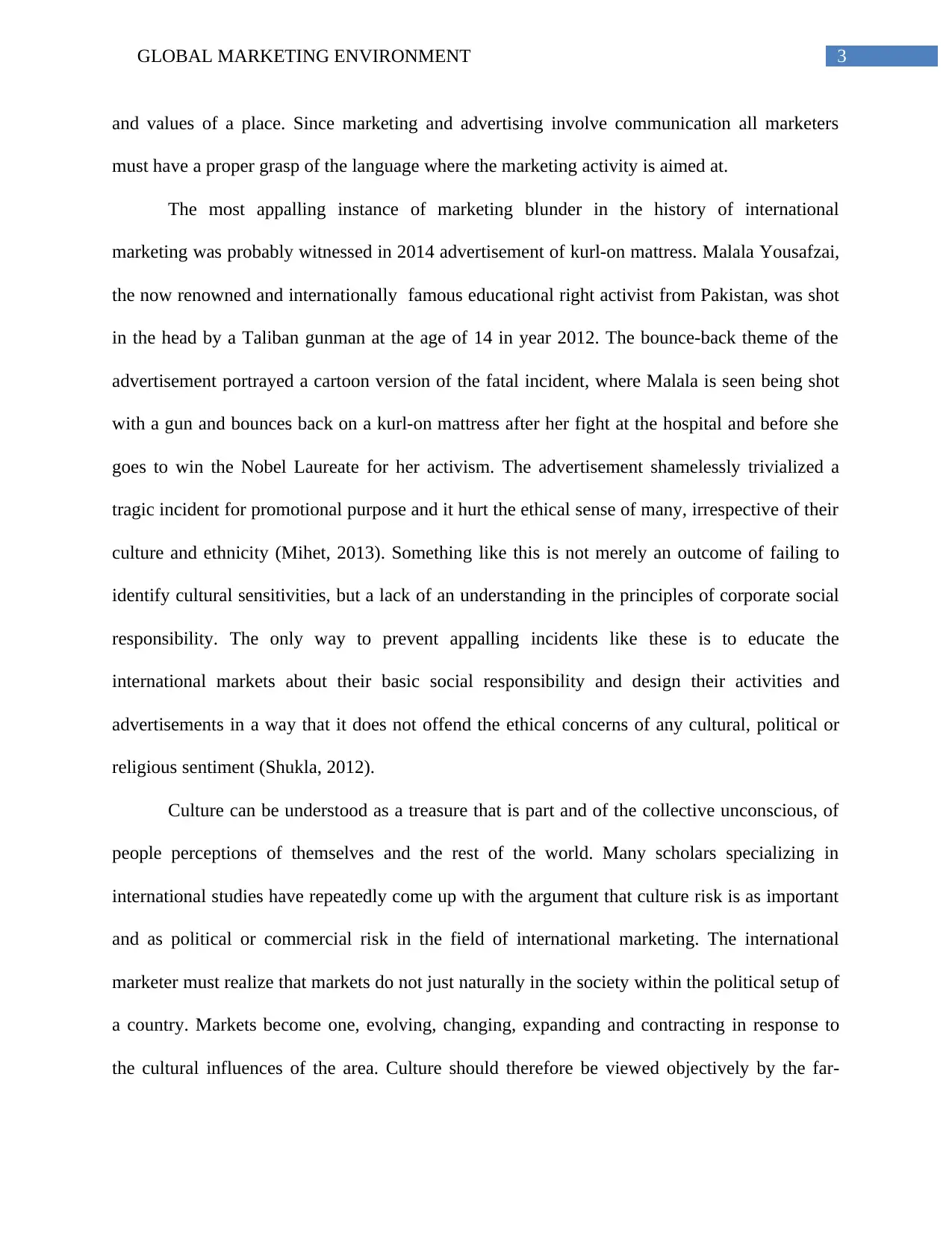
3GLOBAL MARKETING ENVIRONMENT
and values of a place. Since marketing and advertising involve communication all marketers
must have a proper grasp of the language where the marketing activity is aimed at.
The most appalling instance of marketing blunder in the history of international
marketing was probably witnessed in 2014 advertisement of kurl-on mattress. Malala Yousafzai,
the now renowned and internationally famous educational right activist from Pakistan, was shot
in the head by a Taliban gunman at the age of 14 in year 2012. The bounce-back theme of the
advertisement portrayed a cartoon version of the fatal incident, where Malala is seen being shot
with a gun and bounces back on a kurl-on mattress after her fight at the hospital and before she
goes to win the Nobel Laureate for her activism. The advertisement shamelessly trivialized a
tragic incident for promotional purpose and it hurt the ethical sense of many, irrespective of their
culture and ethnicity (Mihet, 2013). Something like this is not merely an outcome of failing to
identify cultural sensitivities, but a lack of an understanding in the principles of corporate social
responsibility. The only way to prevent appalling incidents like these is to educate the
international markets about their basic social responsibility and design their activities and
advertisements in a way that it does not offend the ethical concerns of any cultural, political or
religious sentiment (Shukla, 2012).
Culture can be understood as a treasure that is part and of the collective unconscious, of
people perceptions of themselves and the rest of the world. Many scholars specializing in
international studies have repeatedly come up with the argument that culture risk is as important
and as political or commercial risk in the field of international marketing. The international
marketer must realize that markets do not just naturally in the society within the political setup of
a country. Markets become one, evolving, changing, expanding and contracting in response to
the cultural influences of the area. Culture should therefore be viewed objectively by the far-
and values of a place. Since marketing and advertising involve communication all marketers
must have a proper grasp of the language where the marketing activity is aimed at.
The most appalling instance of marketing blunder in the history of international
marketing was probably witnessed in 2014 advertisement of kurl-on mattress. Malala Yousafzai,
the now renowned and internationally famous educational right activist from Pakistan, was shot
in the head by a Taliban gunman at the age of 14 in year 2012. The bounce-back theme of the
advertisement portrayed a cartoon version of the fatal incident, where Malala is seen being shot
with a gun and bounces back on a kurl-on mattress after her fight at the hospital and before she
goes to win the Nobel Laureate for her activism. The advertisement shamelessly trivialized a
tragic incident for promotional purpose and it hurt the ethical sense of many, irrespective of their
culture and ethnicity (Mihet, 2013). Something like this is not merely an outcome of failing to
identify cultural sensitivities, but a lack of an understanding in the principles of corporate social
responsibility. The only way to prevent appalling incidents like these is to educate the
international markets about their basic social responsibility and design their activities and
advertisements in a way that it does not offend the ethical concerns of any cultural, political or
religious sentiment (Shukla, 2012).
Culture can be understood as a treasure that is part and of the collective unconscious, of
people perceptions of themselves and the rest of the world. Many scholars specializing in
international studies have repeatedly come up with the argument that culture risk is as important
and as political or commercial risk in the field of international marketing. The international
marketer must realize that markets do not just naturally in the society within the political setup of
a country. Markets become one, evolving, changing, expanding and contracting in response to
the cultural influences of the area. Culture should therefore be viewed objectively by the far-
Paraphrase This Document
Need a fresh take? Get an instant paraphrase of this document with our AI Paraphraser
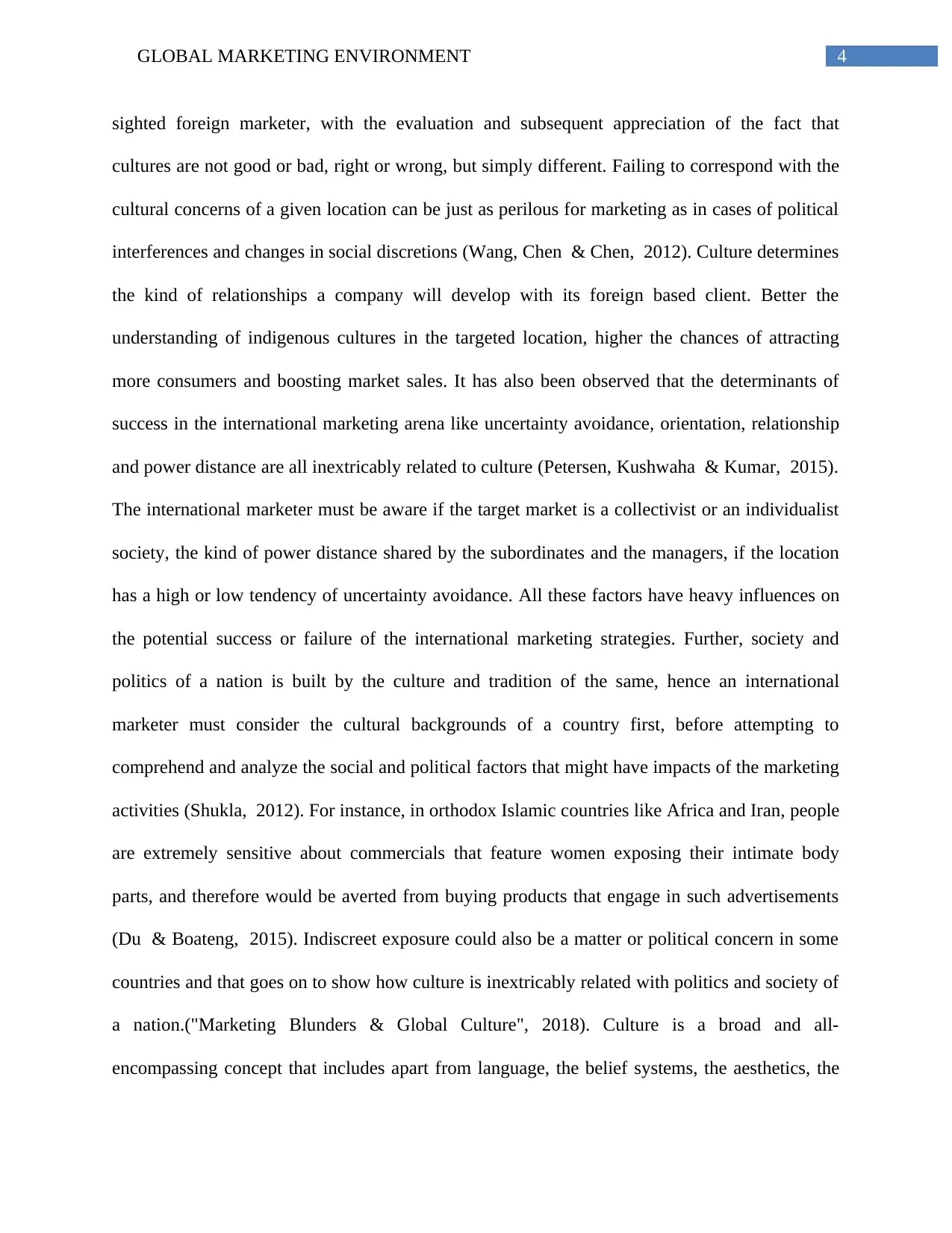
4GLOBAL MARKETING ENVIRONMENT
sighted foreign marketer, with the evaluation and subsequent appreciation of the fact that
cultures are not good or bad, right or wrong, but simply different. Failing to correspond with the
cultural concerns of a given location can be just as perilous for marketing as in cases of political
interferences and changes in social discretions (Wang, Chen & Chen, 2012). Culture determines
the kind of relationships a company will develop with its foreign based client. Better the
understanding of indigenous cultures in the targeted location, higher the chances of attracting
more consumers and boosting market sales. It has also been observed that the determinants of
success in the international marketing arena like uncertainty avoidance, orientation, relationship
and power distance are all inextricably related to culture (Petersen, Kushwaha & Kumar, 2015).
The international marketer must be aware if the target market is a collectivist or an individualist
society, the kind of power distance shared by the subordinates and the managers, if the location
has a high or low tendency of uncertainty avoidance. All these factors have heavy influences on
the potential success or failure of the international marketing strategies. Further, society and
politics of a nation is built by the culture and tradition of the same, hence an international
marketer must consider the cultural backgrounds of a country first, before attempting to
comprehend and analyze the social and political factors that might have impacts of the marketing
activities (Shukla, 2012). For instance, in orthodox Islamic countries like Africa and Iran, people
are extremely sensitive about commercials that feature women exposing their intimate body
parts, and therefore would be averted from buying products that engage in such advertisements
(Du & Boateng, 2015). Indiscreet exposure could also be a matter or political concern in some
countries and that goes on to show how culture is inextricably related with politics and society of
a nation.("Marketing Blunders & Global Culture", 2018). Culture is a broad and all-
encompassing concept that includes apart from language, the belief systems, the aesthetics, the
sighted foreign marketer, with the evaluation and subsequent appreciation of the fact that
cultures are not good or bad, right or wrong, but simply different. Failing to correspond with the
cultural concerns of a given location can be just as perilous for marketing as in cases of political
interferences and changes in social discretions (Wang, Chen & Chen, 2012). Culture determines
the kind of relationships a company will develop with its foreign based client. Better the
understanding of indigenous cultures in the targeted location, higher the chances of attracting
more consumers and boosting market sales. It has also been observed that the determinants of
success in the international marketing arena like uncertainty avoidance, orientation, relationship
and power distance are all inextricably related to culture (Petersen, Kushwaha & Kumar, 2015).
The international marketer must be aware if the target market is a collectivist or an individualist
society, the kind of power distance shared by the subordinates and the managers, if the location
has a high or low tendency of uncertainty avoidance. All these factors have heavy influences on
the potential success or failure of the international marketing strategies. Further, society and
politics of a nation is built by the culture and tradition of the same, hence an international
marketer must consider the cultural backgrounds of a country first, before attempting to
comprehend and analyze the social and political factors that might have impacts of the marketing
activities (Shukla, 2012). For instance, in orthodox Islamic countries like Africa and Iran, people
are extremely sensitive about commercials that feature women exposing their intimate body
parts, and therefore would be averted from buying products that engage in such advertisements
(Du & Boateng, 2015). Indiscreet exposure could also be a matter or political concern in some
countries and that goes on to show how culture is inextricably related with politics and society of
a nation.("Marketing Blunders & Global Culture", 2018). Culture is a broad and all-
encompassing concept that includes apart from language, the belief systems, the aesthetics, the
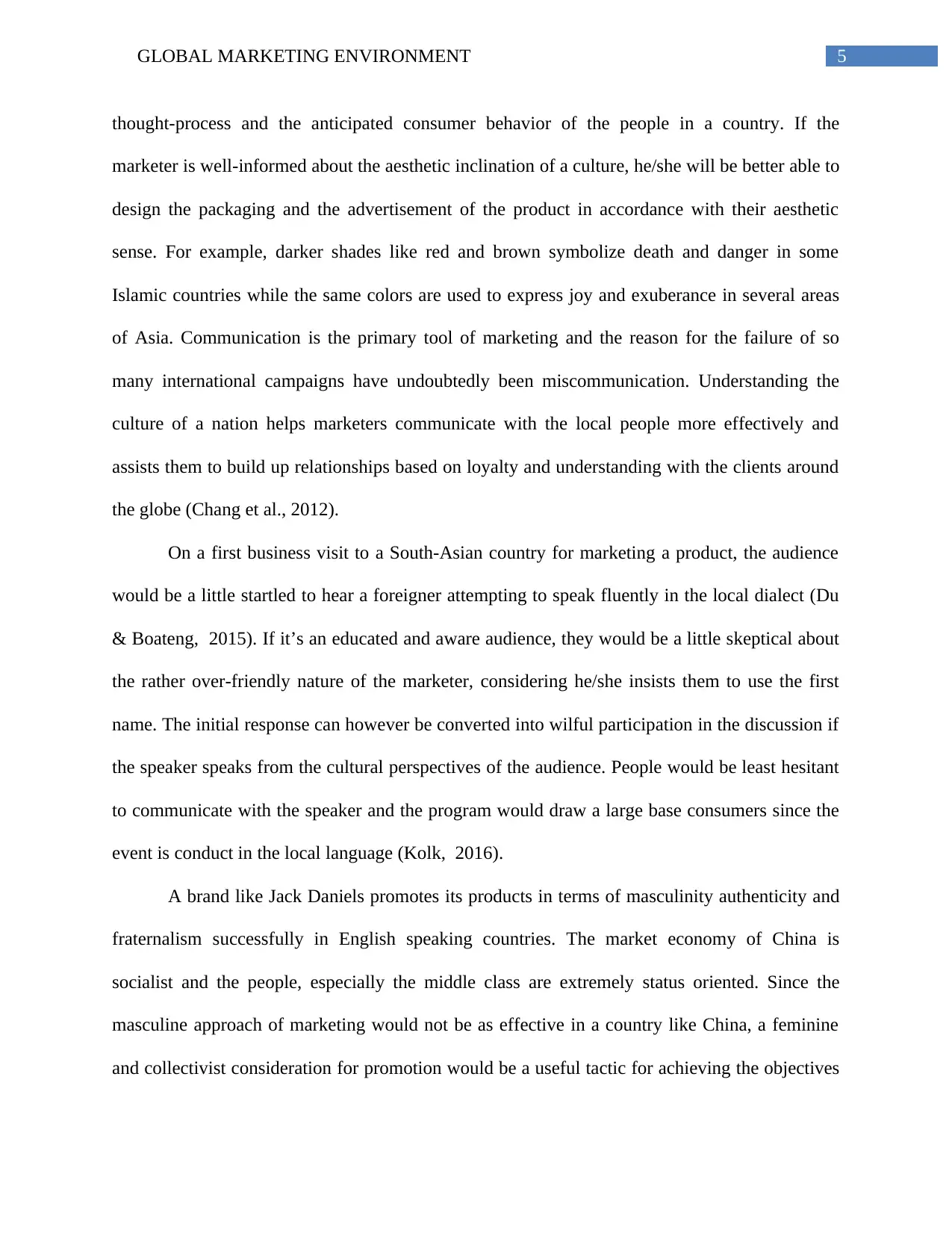
5GLOBAL MARKETING ENVIRONMENT
thought-process and the anticipated consumer behavior of the people in a country. If the
marketer is well-informed about the aesthetic inclination of a culture, he/she will be better able to
design the packaging and the advertisement of the product in accordance with their aesthetic
sense. For example, darker shades like red and brown symbolize death and danger in some
Islamic countries while the same colors are used to express joy and exuberance in several areas
of Asia. Communication is the primary tool of marketing and the reason for the failure of so
many international campaigns have undoubtedly been miscommunication. Understanding the
culture of a nation helps marketers communicate with the local people more effectively and
assists them to build up relationships based on loyalty and understanding with the clients around
the globe (Chang et al., 2012).
On a first business visit to a South-Asian country for marketing a product, the audience
would be a little startled to hear a foreigner attempting to speak fluently in the local dialect (Du
& Boateng, 2015). If it’s an educated and aware audience, they would be a little skeptical about
the rather over-friendly nature of the marketer, considering he/she insists them to use the first
name. The initial response can however be converted into wilful participation in the discussion if
the speaker speaks from the cultural perspectives of the audience. People would be least hesitant
to communicate with the speaker and the program would draw a large base consumers since the
event is conduct in the local language (Kolk, 2016).
A brand like Jack Daniels promotes its products in terms of masculinity authenticity and
fraternalism successfully in English speaking countries. The market economy of China is
socialist and the people, especially the middle class are extremely status oriented. Since the
masculine approach of marketing would not be as effective in a country like China, a feminine
and collectivist consideration for promotion would be a useful tactic for achieving the objectives
thought-process and the anticipated consumer behavior of the people in a country. If the
marketer is well-informed about the aesthetic inclination of a culture, he/she will be better able to
design the packaging and the advertisement of the product in accordance with their aesthetic
sense. For example, darker shades like red and brown symbolize death and danger in some
Islamic countries while the same colors are used to express joy and exuberance in several areas
of Asia. Communication is the primary tool of marketing and the reason for the failure of so
many international campaigns have undoubtedly been miscommunication. Understanding the
culture of a nation helps marketers communicate with the local people more effectively and
assists them to build up relationships based on loyalty and understanding with the clients around
the globe (Chang et al., 2012).
On a first business visit to a South-Asian country for marketing a product, the audience
would be a little startled to hear a foreigner attempting to speak fluently in the local dialect (Du
& Boateng, 2015). If it’s an educated and aware audience, they would be a little skeptical about
the rather over-friendly nature of the marketer, considering he/she insists them to use the first
name. The initial response can however be converted into wilful participation in the discussion if
the speaker speaks from the cultural perspectives of the audience. People would be least hesitant
to communicate with the speaker and the program would draw a large base consumers since the
event is conduct in the local language (Kolk, 2016).
A brand like Jack Daniels promotes its products in terms of masculinity authenticity and
fraternalism successfully in English speaking countries. The market economy of China is
socialist and the people, especially the middle class are extremely status oriented. Since the
masculine approach of marketing would not be as effective in a country like China, a feminine
and collectivist consideration for promotion would be a useful tactic for achieving the objectives
⊘ This is a preview!⊘
Do you want full access?
Subscribe today to unlock all pages.

Trusted by 1+ million students worldwide
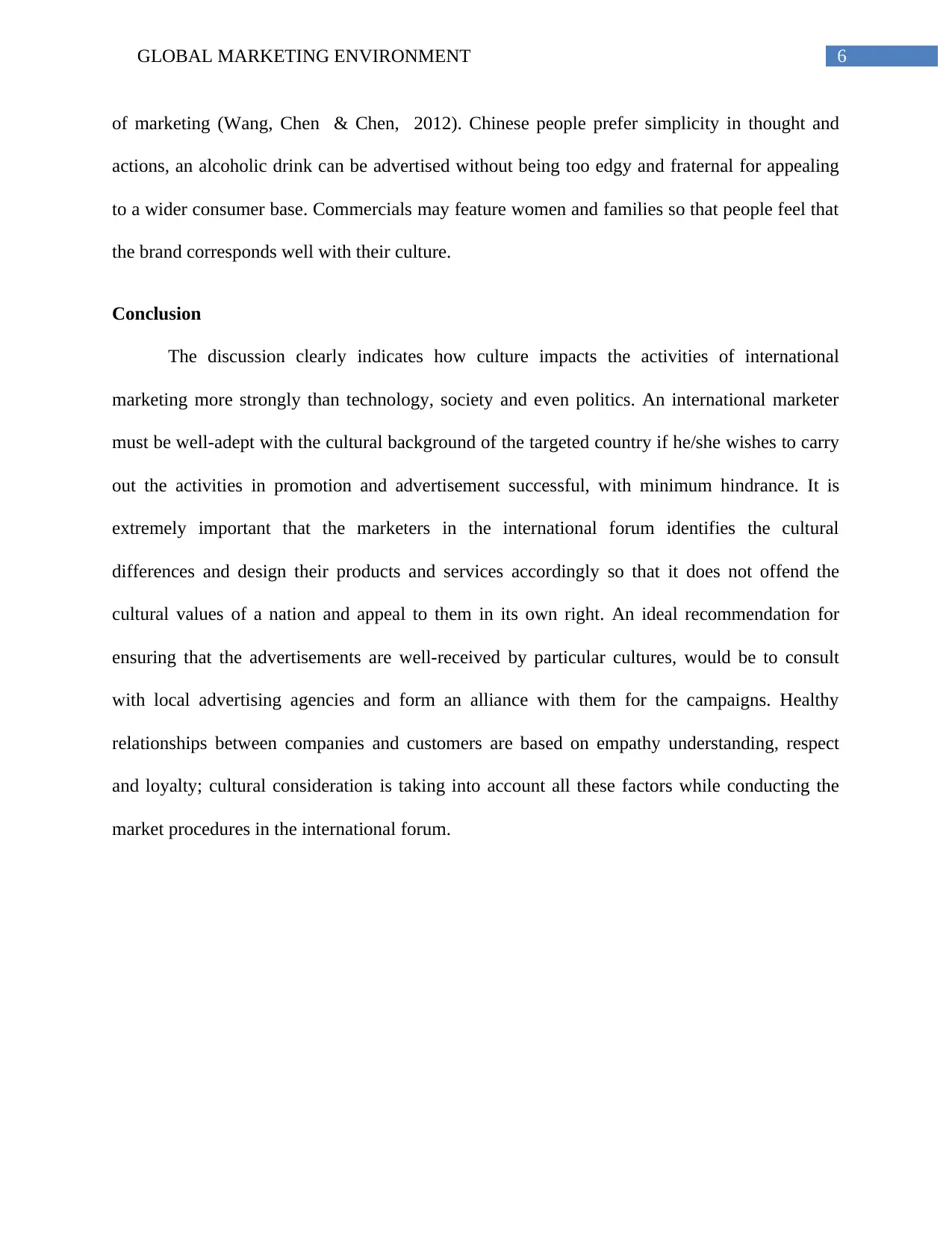
6GLOBAL MARKETING ENVIRONMENT
of marketing (Wang, Chen & Chen, 2012). Chinese people prefer simplicity in thought and
actions, an alcoholic drink can be advertised without being too edgy and fraternal for appealing
to a wider consumer base. Commercials may feature women and families so that people feel that
the brand corresponds well with their culture.
Conclusion
The discussion clearly indicates how culture impacts the activities of international
marketing more strongly than technology, society and even politics. An international marketer
must be well-adept with the cultural background of the targeted country if he/she wishes to carry
out the activities in promotion and advertisement successful, with minimum hindrance. It is
extremely important that the marketers in the international forum identifies the cultural
differences and design their products and services accordingly so that it does not offend the
cultural values of a nation and appeal to them in its own right. An ideal recommendation for
ensuring that the advertisements are well-received by particular cultures, would be to consult
with local advertising agencies and form an alliance with them for the campaigns. Healthy
relationships between companies and customers are based on empathy understanding, respect
and loyalty; cultural consideration is taking into account all these factors while conducting the
market procedures in the international forum.
of marketing (Wang, Chen & Chen, 2012). Chinese people prefer simplicity in thought and
actions, an alcoholic drink can be advertised without being too edgy and fraternal for appealing
to a wider consumer base. Commercials may feature women and families so that people feel that
the brand corresponds well with their culture.
Conclusion
The discussion clearly indicates how culture impacts the activities of international
marketing more strongly than technology, society and even politics. An international marketer
must be well-adept with the cultural background of the targeted country if he/she wishes to carry
out the activities in promotion and advertisement successful, with minimum hindrance. It is
extremely important that the marketers in the international forum identifies the cultural
differences and design their products and services accordingly so that it does not offend the
cultural values of a nation and appeal to them in its own right. An ideal recommendation for
ensuring that the advertisements are well-received by particular cultures, would be to consult
with local advertising agencies and form an alliance with them for the campaigns. Healthy
relationships between companies and customers are based on empathy understanding, respect
and loyalty; cultural consideration is taking into account all these factors while conducting the
market procedures in the international forum.
Paraphrase This Document
Need a fresh take? Get an instant paraphrase of this document with our AI Paraphraser
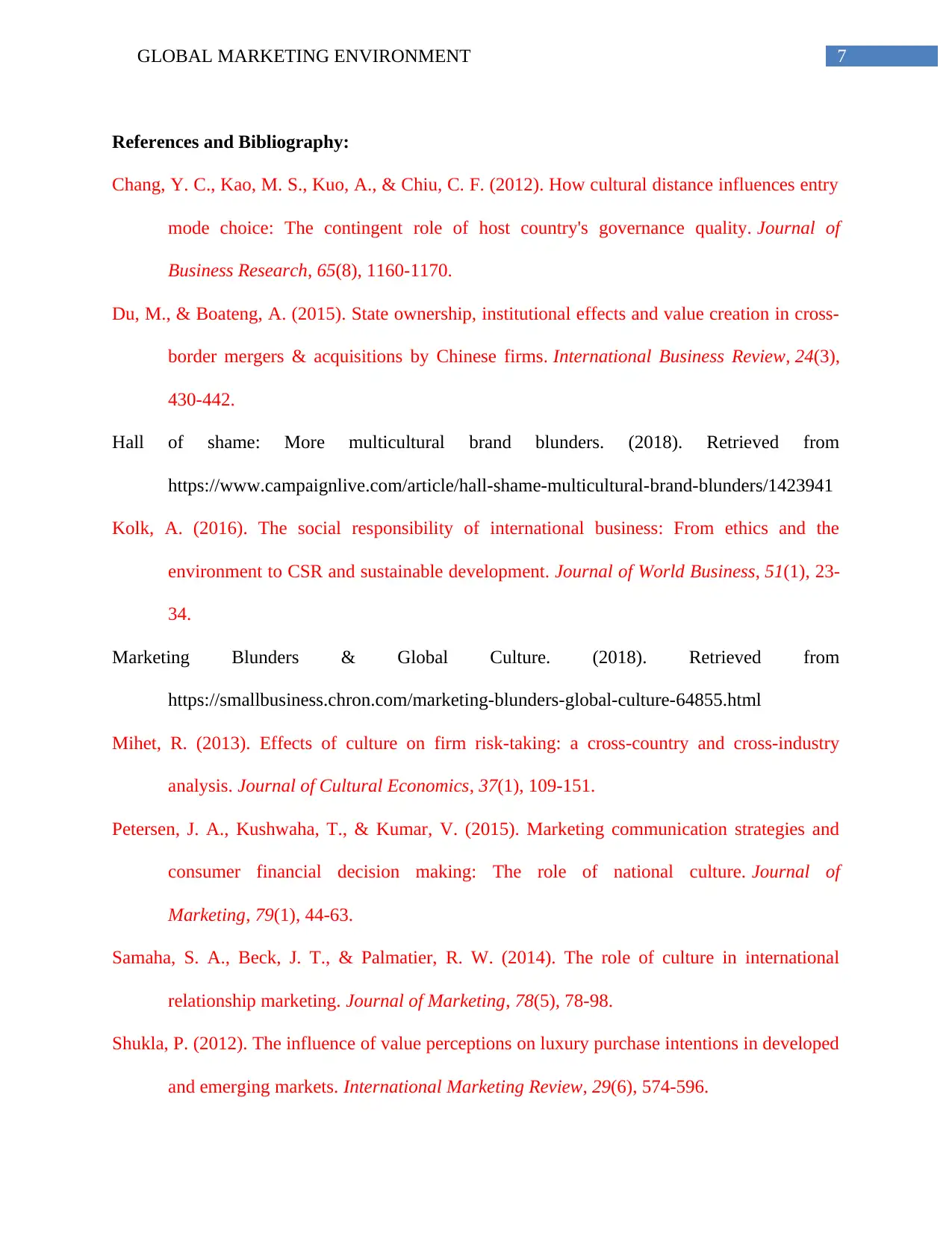
7GLOBAL MARKETING ENVIRONMENT
References and Bibliography:
Chang, Y. C., Kao, M. S., Kuo, A., & Chiu, C. F. (2012). How cultural distance influences entry
mode choice: The contingent role of host country's governance quality. Journal of
Business Research, 65(8), 1160-1170.
Du, M., & Boateng, A. (2015). State ownership, institutional effects and value creation in cross-
border mergers & acquisitions by Chinese firms. International Business Review, 24(3),
430-442.
Hall of shame: More multicultural brand blunders. (2018). Retrieved from
https://www.campaignlive.com/article/hall-shame-multicultural-brand-blunders/1423941
Kolk, A. (2016). The social responsibility of international business: From ethics and the
environment to CSR and sustainable development. Journal of World Business, 51(1), 23-
34.
Marketing Blunders & Global Culture. (2018). Retrieved from
https://smallbusiness.chron.com/marketing-blunders-global-culture-64855.html
Mihet, R. (2013). Effects of culture on firm risk-taking: a cross-country and cross-industry
analysis. Journal of Cultural Economics, 37(1), 109-151.
Petersen, J. A., Kushwaha, T., & Kumar, V. (2015). Marketing communication strategies and
consumer financial decision making: The role of national culture. Journal of
Marketing, 79(1), 44-63.
Samaha, S. A., Beck, J. T., & Palmatier, R. W. (2014). The role of culture in international
relationship marketing. Journal of Marketing, 78(5), 78-98.
Shukla, P. (2012). The influence of value perceptions on luxury purchase intentions in developed
and emerging markets. International Marketing Review, 29(6), 574-596.
References and Bibliography:
Chang, Y. C., Kao, M. S., Kuo, A., & Chiu, C. F. (2012). How cultural distance influences entry
mode choice: The contingent role of host country's governance quality. Journal of
Business Research, 65(8), 1160-1170.
Du, M., & Boateng, A. (2015). State ownership, institutional effects and value creation in cross-
border mergers & acquisitions by Chinese firms. International Business Review, 24(3),
430-442.
Hall of shame: More multicultural brand blunders. (2018). Retrieved from
https://www.campaignlive.com/article/hall-shame-multicultural-brand-blunders/1423941
Kolk, A. (2016). The social responsibility of international business: From ethics and the
environment to CSR and sustainable development. Journal of World Business, 51(1), 23-
34.
Marketing Blunders & Global Culture. (2018). Retrieved from
https://smallbusiness.chron.com/marketing-blunders-global-culture-64855.html
Mihet, R. (2013). Effects of culture on firm risk-taking: a cross-country and cross-industry
analysis. Journal of Cultural Economics, 37(1), 109-151.
Petersen, J. A., Kushwaha, T., & Kumar, V. (2015). Marketing communication strategies and
consumer financial decision making: The role of national culture. Journal of
Marketing, 79(1), 44-63.
Samaha, S. A., Beck, J. T., & Palmatier, R. W. (2014). The role of culture in international
relationship marketing. Journal of Marketing, 78(5), 78-98.
Shukla, P. (2012). The influence of value perceptions on luxury purchase intentions in developed
and emerging markets. International Marketing Review, 29(6), 574-596.

8GLOBAL MARKETING ENVIRONMENT
Wang, C. H., Chen, K. Y., & Chen, S. C. (2012). Total quality management, market orientation
and hotel performance: The moderating effects of external environmental
factors. International Journal of Hospitality Management, 31(1), 119-129.
Wang, C. H., Chen, K. Y., & Chen, S. C. (2012). Total quality management, market orientation
and hotel performance: The moderating effects of external environmental
factors. International Journal of Hospitality Management, 31(1), 119-129.
⊘ This is a preview!⊘
Do you want full access?
Subscribe today to unlock all pages.

Trusted by 1+ million students worldwide
1 out of 9
Related Documents
Your All-in-One AI-Powered Toolkit for Academic Success.
+13062052269
info@desklib.com
Available 24*7 on WhatsApp / Email
![[object Object]](/_next/static/media/star-bottom.7253800d.svg)
Unlock your academic potential
Copyright © 2020–2025 A2Z Services. All Rights Reserved. Developed and managed by ZUCOL.





